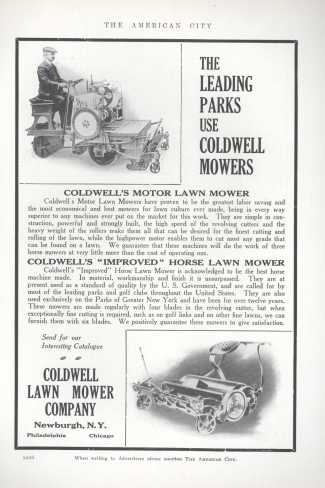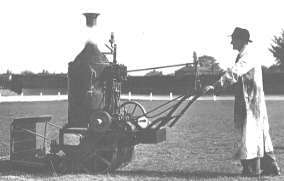An annual re-post -
 Lawns are dumb things to have, but almost everybody has some. It's expected nowadays, but gardens and plantings are more interesting, look more natural, are more inviting to birds and other friendly critters, and offer more privacy - and shade. On the other hand, everyone needs a space for croquet and badminton.
Lawns are dumb things to have, but almost everybody has some. It's expected nowadays, but gardens and plantings are more interesting, look more natural, are more inviting to birds and other friendly critters, and offer more privacy - and shade. On the other hand, everyone needs a space for croquet and badminton.
Once the preserve of the wealthy, lawns became de rigeur for the aspiring middle class during the 20th century, as new homeowners attempted to create miniaturized versions of grand English estates on 1/4, 1/2, 1- and 2-acre building lots.
The orgin of lawns was sheep-grazed fields. Sheep are the primitive machine which transforms grass into wool and mutton.
But the subject assigned to me is top dressing. (Bear in mind that I am talking about Northern and mid-western lawns with Bluegrass and fescue in them. That's all I know about. Southern lawns are an entirely different breed.)
I top dress my lawns every spring, and I know Bird Dog does too. He does it casually, but I do it methodically. I mix about 1/4 leaf compost, 1/8 light sand, 1/8 topsoil or potting soil, 1/4 peat moss and 1/4 composted manure in the big wheelbarrow and toss it around the ground after around the second grass cutting of spring. Probably plain peat moss or composted manure would do the trick just as well. Ideally, it all should be rather dry, but life is never ideal. Then I lightly rake it in - or have the lawn guys rake it in - so it doesn't compress the grass. I apply it rather heavily, and use around 40 wheelbarrow loads for the lawn areas I care about.
It's about stewardship of the land, and not a cheap nitrogen-intoxicated superficial green. We have to remember that lawns are not natural things, but they aren't plastic either.
(More lawn info and advice below the fold)
It makes for a spongy, lush, humusy growth which doesn't need much watering. It's almost like mulching the grass. And the soil has become thick with worms since I have been doing this, which is a good sign. The worm population saves me the trouble of doing an annual or biennial coring. The worms do it for me.
 Because lawns are unnatural things, they need special treatment to be healthy. What our lawn grasses want to do is to grow to their maximum height by July, go to seed, turn brown, and green up again from the base in the fall - and mulch themselves with their stalks, fallen leaves, etc. over the winter. That's what a meadow, a prairie, or a woodland grassy patch does. Mowing fools the grasses into continuing growth by chopping off their tops.
Because lawns are unnatural things, they need special treatment to be healthy. What our lawn grasses want to do is to grow to their maximum height by July, go to seed, turn brown, and green up again from the base in the fall - and mulch themselves with their stalks, fallen leaves, etc. over the winter. That's what a meadow, a prairie, or a woodland grassy patch does. Mowing fools the grasses into continuing growth by chopping off their tops.
Is my top dressing ritual really necessary? Some say not, but I do it anyway, most years. Here's how I do my lawn areas that I want to look good:
- Annual top dressing after second or third cut
- Early spring organic fertilizer in April at start of green-up
- Early spring crab-grass preventer
- Lime in later spring, if needed by pH check. Sometimes I apply it anyway - it's "the poor
man's fertilizer"
- Late June light application of organic fert.
- September/October - organic fert.
- Occasional coring, when I feel like it. Maybe every 2 or 3 years, in May when the
grass is growing fast.
 I do not use weed-killer or pesticides. The turf is happy enough to crowd out everything except for the occasional cheerful dandelion, and lawn pesticides are entirely unnecessary in a healthy lawn. Plus they kill all the worms and everything else. I do not use high nitrogen fertilizers. They give you a cheap green for a week, and 90% of the fertilizer washes away. The organic fertilizers are slow release and much lower in nitrogen. For a happy lawn, you need strong roots and not picture-perfect green. In fact, you can maintain a picture-perfect lawn by irrigation and high-nitrogen fertilizer, but it won't be healthy: it's like applying make-up.
I do not use weed-killer or pesticides. The turf is happy enough to crowd out everything except for the occasional cheerful dandelion, and lawn pesticides are entirely unnecessary in a healthy lawn. Plus they kill all the worms and everything else. I do not use high nitrogen fertilizers. They give you a cheap green for a week, and 90% of the fertilizer washes away. The organic fertilizers are slow release and much lower in nitrogen. For a happy lawn, you need strong roots and not picture-perfect green. In fact, you can maintain a picture-perfect lawn by irrigation and high-nitrogen fertilizer, but it won't be healthy: it's like applying make-up.
I do not water my lawns at all. They naturally turn a bit brown (dormant) in August, and bounce back happily in September after their little summer rest. Lastly, I let the lawn clippings lie where they fall to mulch the grass, except in May when the growth is so fast that the clippings would kill the grass.
Leaving the clippings on the grass is, of course, an additional form of top dressing. Another is to run the mulching mower over the fallen leaves in autumn, rather than blowing them all away.
(If you know anyone who is interested, I have a patent on a pelletized top dressing which can be applied by a lawn spreader and would not need raking-in. I just need an investor-manufacturer.)
Middle image: A 1911 ad for the Coldwell mowers. Note that the lower machine is horse-drawn. They used to put boots on the horses so as not to create hoof divets in the lawns.
Lower image: A Leyland steam-powered mower


 Lawns are dumb things to have, but almost everybody has some. It's expected nowadays, but gardens and plantings are more interesting, look more natural, are more inviting to birds and other friendly critters, and offer more privacy - and shade. On the other hand, everyone needs a space for croquet and badminton.
Lawns are dumb things to have, but almost everybody has some. It's expected nowadays, but gardens and plantings are more interesting, look more natural, are more inviting to birds and other friendly critters, and offer more privacy - and shade. On the other hand, everyone needs a space for croquet and badminton.  Because lawns are unnatural things, they need special treatment to be healthy. What our lawn grasses want to do is to grow to their maximum height by July, go to seed, turn brown, and green up again from the base in the fall - and mulch themselves with their stalks, fallen leaves, etc. over the winter. That's what a meadow, a prairie, or a woodland grassy patch does. Mowing fools the grasses into continuing growth by chopping off their tops.
Because lawns are unnatural things, they need special treatment to be healthy. What our lawn grasses want to do is to grow to their maximum height by July, go to seed, turn brown, and green up again from the base in the fall - and mulch themselves with their stalks, fallen leaves, etc. over the winter. That's what a meadow, a prairie, or a woodland grassy patch does. Mowing fools the grasses into continuing growth by chopping off their tops. I do not use weed-killer or pesticides. The turf is happy enough to crowd out everything except for the occasional cheerful dandelion, and lawn pesticides are entirely unnecessary in a healthy lawn. Plus they kill all the worms and everything else. I do not use high nitrogen fertilizers. They give you a cheap green for a week, and 90% of the fertilizer washes away. The organic fertilizers are slow release and much lower in nitrogen. For a happy lawn, you need strong roots and not picture-perfect green. In fact, you can maintain a picture-perfect lawn by irrigation and high-nitrogen fertilizer, but it won't be healthy: it's like applying make-up.
I do not use weed-killer or pesticides. The turf is happy enough to crowd out everything except for the occasional cheerful dandelion, and lawn pesticides are entirely unnecessary in a healthy lawn. Plus they kill all the worms and everything else. I do not use high nitrogen fertilizers. They give you a cheap green for a week, and 90% of the fertilizer washes away. The organic fertilizers are slow release and much lower in nitrogen. For a happy lawn, you need strong roots and not picture-perfect green. In fact, you can maintain a picture-perfect lawn by irrigation and high-nitrogen fertilizer, but it won't be healthy: it's like applying make-up.